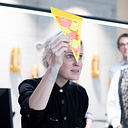Correlation vs. Causation…..or as I am titling it… “Shark side of the Moon”
Did you know that the full moon causes sharks to go feral, embarking on a human-chomping lunar mission?
Yes? No? Well that’s because its not really true…. but it was great Daily Fail fodder…
At one point, research revealed a curious correlation: more unprovoked shark attacks occurred during a full moon. The result? Stories were spun about were-sharks in a lunar flesh frenzy.
But let’s consider another piece of data that correlates: more unprovoked shark attacks happen when ice cream sales increase. This seems less plausible, so researchers dig deeper — seasonal trends, more swimmers in the water, warmer weather.
Here’s the thing — both pieces of data correlate, but one just seems more feasible to our pattern-loving brains. And this is where the vital principle comes in: “correlation does not imply causation.”
Humans, as Michael Shermer says, are “pattern-seeking, story-telling animals, and we are quite adept at telling stories about patterns, whether they exist or not.” Designers, researchers, and decision-makers in User-Centred Design (UCD) need to stay vigilant to avoid falling into this trap.
The Danger of Assumptions…. Correlation means two things happen together, but it doesn’t mean one causes the other. Causation, on the other hand, proves that one event leads directly to another. The full moon might impact shark behaviour due to tides or prey movement, but we need evidence, not assumptions, to validate the cause.
As design and research folks, we work with data to understand user behaviour, but jumping to conclusions without exploring causation can lead to flawed designs and misguided solutions. For example, if data shows users spend less time on a page, it could correlate with poor design — or it could simply be that they found what they needed faster.
By questioning assumptions and seeking evidence of causation, we build designs rooted in reality — not stories that only seem to make sense, or tantalise our story seeking brain buds.
Lets wrap this up with a bit of design and research vibe and some bullet points to make my friend Liberty a content designer proud of me….
Understanding correlation vs. causation is essential for researchers and designers. It’s the difference between solving the right problem or wasting time fixing the wrong one.
- Correlation shows two things are linked; causation shows one drives the other. Sharks and ice cream sales? They’re correlated, but ice cream doesn’t cause shark attacks. It’s just summer.
- Misreading this can lead to bad bad decisions. Users drop off a page? Don’t assume it’s the layout — dig deeper ask those why’s (5x) It might be unclear navigation or something external entirely.
Knowing causation helps you:
Avoid False Assumptions: Correlation isn’t always what it seems, and acting on it alone risks a load of wasted effort.
- Drive Meaningful Change: Understanding the root cause lets you focus on solutions that actually work.
- Prioritise Resources: Limited time and budget? Spend it on what truly matters by solving the real problem.
- Build Stakeholder Trust: “This works because…” lands better than “We think this might help…” every time.
When you combine correlation to spot patterns with causation to explain the “why,” you make sharper, evidence-backed decisions. Get it right, and you’re designing with purpose — not just hoping for the best.
So next time you see a pattern, pause. Ask yourself: is it a full-moon theory*, or is it the real cause? 🌕✨
